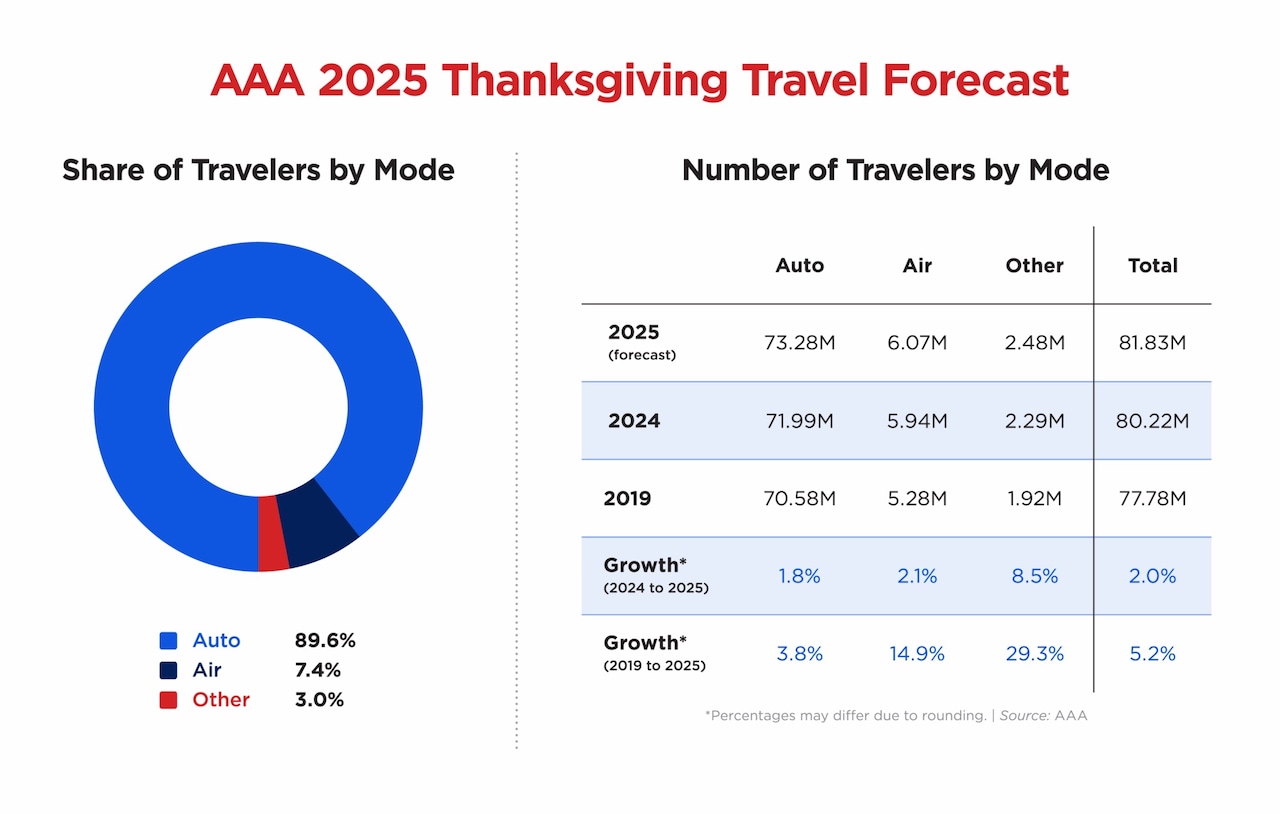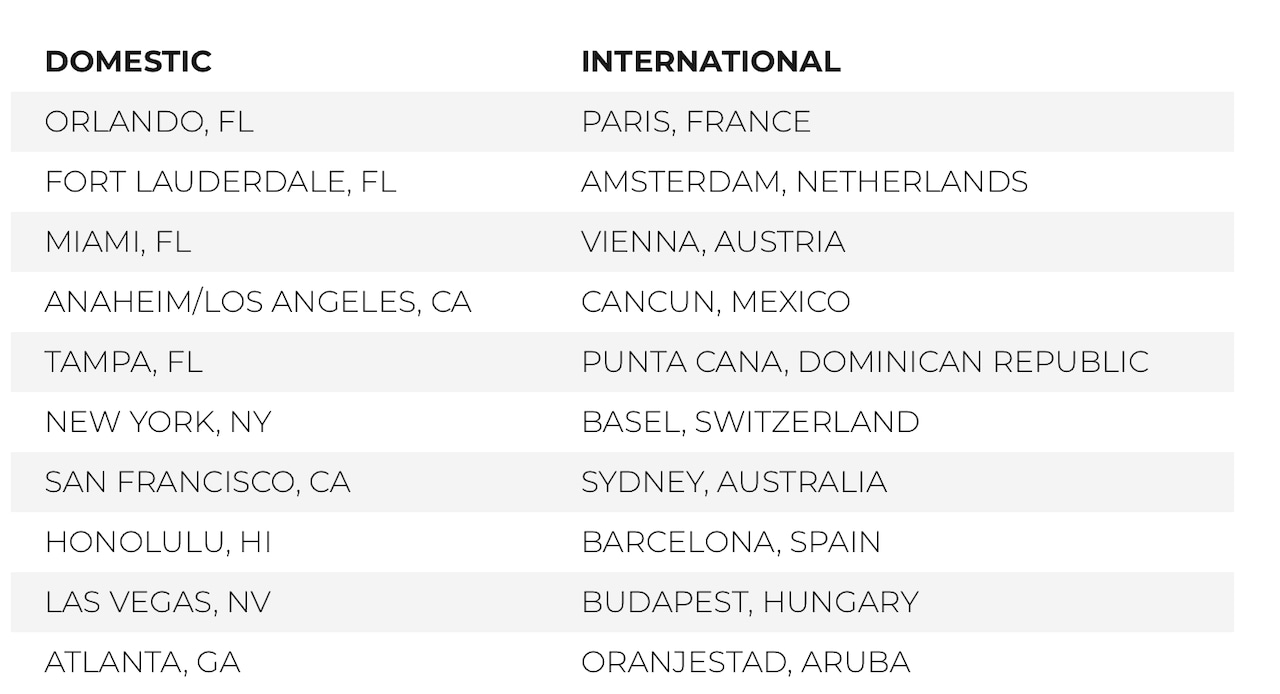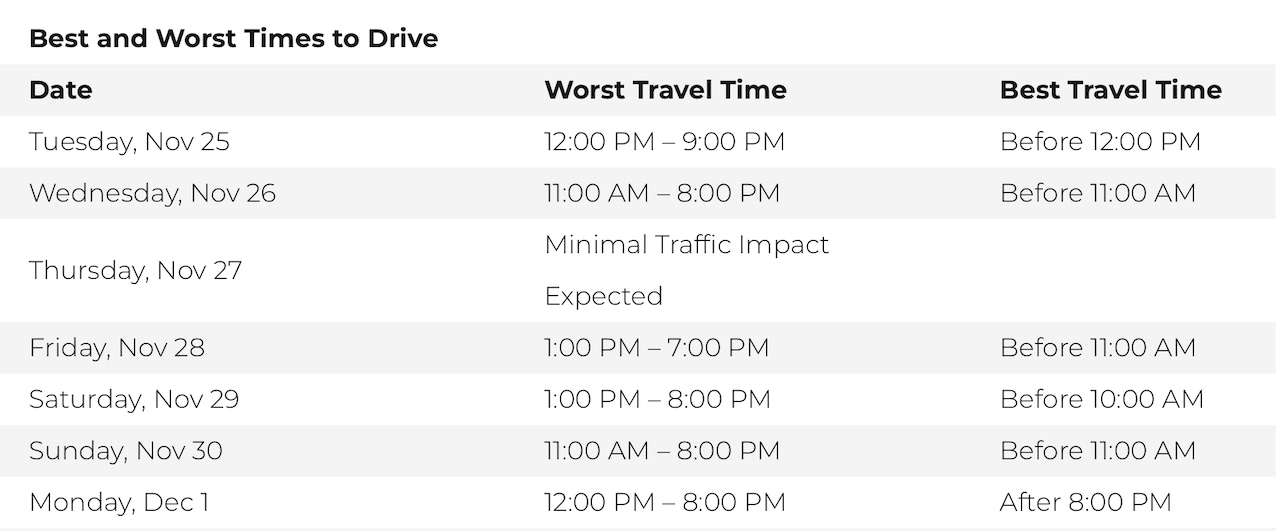The American Automobile Association (AAA) is projecting that nearly 82 million people are traveling at least 50 miles from home during the Thanksgiving week, setting a new overall domestic travel record.
The report states that from Nov. 25 to Dec. 1 there will be an additional 1.6 million travelers compared to last Thanksgiving.
Thanksgiving is considered the single busiest holiday for travel compared to others like Memorial Day and July 4, the association states.
“Thanksgiving travel numbers are always impressive because this holiday has become synonymous with heading out of town to spend time with loved ones,” Vice President of AAA Travel Stacey Barber said in a statement. “People are willing to brave the crowds and make last-minute adjustments to their plans to make lifelong memories, whether it’s visiting extended family or meeting up with friends.”
 Total Thanksgiving holiday travelers 2019 through 2025. (Courtesy of AAA)AAA
Total Thanksgiving holiday travelers 2019 through 2025. (Courtesy of AAA)AAA
AAA predicts that roughly 73 million people are traveling by car during the holiday, which is nearly 90% of Thanksgiving travelers. That’s an additional 1.3 million people on the road compared to last Thanksgiving.
That number could be higher if air travelers change their minds and decide to drive instead, following recent flight cancellations.
For travelers renting cars, AAA car rental partner Hertz said that Wednesday is expected to be the busiest pick-up day, with the top highest demands being in Orlando, Florida, Atlanta, Georgia, Las Vegas, Nevada, and Newark, New Jersey.
Additionally, AAA booking data shows that domestic car rentals are 15% cheaper this Thanksgiving compared to last year.
Gas costs are expected to be the same as 2024, when the national average for a gallon of regular gasoline was $3.06 on Thanksgiving Day.
“Filling the tank is a good idea the night before a road trip since it’s one less thing to do on travel day,” the association said. “AAA also recommends checking your battery and tire pressure. Last Thanksgiving holiday period, AAA responded to nearly 600,000 emergency roadside assistance calls to help stranded drivers with issues like dead batteries, flat tires, and empty fuel tanks.”
The report also urges travelers to be safe when driving, since this time of year is considered particularly deadly.
According to the National Highway Traffic Safety Administration, from 2019 to 2023, the death toll in drunk-driving crashes during Thanksgiving festivities was 869, representing more than 35% of all fatalities in traffic crashes during that holiday period.
“Have a plan in place before Thanksgiving, and use a ride share, designate a sober driver, or take public transit to ensure everyone’s safety,” AAA said.
 AAA 2025 Thanksgiving travel forecast, according to AAA. (Courtesy of AAA)AAA
AAA 2025 Thanksgiving travel forecast, according to AAA. (Courtesy of AAA)AAA
By air, 6 million U.S. travelers are expected to take domestic flights over the Thanksgiving holiday period, a 2% increase compared to 2024. The number of Thanksgiving air travelers over the past several years, with the exception of 2020, has been between five and six million, the statement reads.
A domestic flight roundtrip ticket is averaging $700, which is similar to last year, but is cheaper to fly on Thanksgiving Day. Flying home is what drives up the ticket price since Sunday and Monday are the busiest return days.
Some travelers shorten or extend their Thanksgiving trips to avoid flying on peak days.
Other modes of travel are also expected to increase by 8.5% to nearly 2.5 million people. Those travelers are taking bus, train and cruise.
Buses and trains could see an uptick in last-minute bookings this year. Cruising is building on its record post-pandemic growth.
This year alone, AAA is projecting 20.7 million American cruise passengers and that number is even higher for 2026 with AAA forecasting 21.7 million U.S. travelers taking ocean cruisers.
“Cruise vacations are appealing during Thanksgiving, especially to the Caribbean, because the weather is mild, the trip is paid in advance, and families can bring grandparents and kids, and everyone is entertained,” the statement reads.
Based on AAA booking data for the Thanksgiving travel period, Florida is considered the most popular domestic destination, thanks to the state’s theme parks and cruise ports.
The international list features a mix of Europe, the Caribbean and Australia for its warm spring weather this time of year.
 AAA’s Thanksgiving top destinations. (Courtesy of AAA)AAA
AAA’s Thanksgiving top destinations. (Courtesy of AAA)AAA
INRIX, a provider of transportation data and insights, expects Tuesday and Wednesday afternoon to be the most congested periods before Thanksgiving Day.
AAA suggests that travelers returning home on Sunday should expect heavy traffic most of the day and should consider hitting the road in the morning to avoid the worst backups.
 Best and worst times to drive during Thanksgiving weekend, according to AAA. (Courtesy of AAA)AAA
Best and worst times to drive during Thanksgiving weekend, according to AAA. (Courtesy of AAA)AAA
AAA has outlined the peak congestion periods based on metro, with Boston to Hyannis via the Pilgrims Highway south having a peak congestion period on Thursday at 11:45 a.m.
Here’s AAA’s full list of congestion periods by metro:
Atlanta (Atlanta to Savannah via I-16 E)Peak Congestion Period: Sunday, 3:30 PMEst. Travel Time: 5 hours 16 minutesIncrease Compared to Typical: 53%Boston (Boston to Hyannis via Pilgrims Hwy S)Peak Congestion Period: Thursday, 11:45 AMEst. Travel Time: 2 hours 0 minutesIncrease Compared to Typical: 108%Chicago (Indianapolis to Chicago via I-65 N)Peak Congestion Period: Sunday, 3:45 PMEst. Travel Time: 4 hours 8 minutesIncrease Compared to Typical: 57%Denver (Pueblo to Denver via I-25 N)Peak Congestion Period: Tuesday, 5:30 PMEst. Travel Time: 2 hours 60 minutes (3 hours 0 minutes)Increase Compared to Typical: 64%Detroit (Kalamazoo to Detroit via I-94 E)Peak Congestion Period: Tuesday, 4:30 PMEst. Travel Time: 2 hours 54 minutesIncrease Compared to Typical: 48%Houston (Galveston to Houston via I-45 N)Peak Congestion Period: Tuesday, 5:30 PMEst. Travel Time: 1 hour 15 minutesIncrease Compared to Typical: 47%Los Angeles (Los Angeles to Bakersfield via I-5 N)Peak Congestion Period: Wednesday, 7:45 PMEst. Travel Time: 4 hours 10 minutesIncrease Compared to Typical: 147%Minneapolis (Eau Claire to Minneapolis via I-94 W)Peak Congestion Period: Sunday, 4:45 PMEst. Travel Time: 1 hour 49 minutesIncrease Compared to Typical: 53%New York (New York to Hamptons via Long Island Expy E)Peak Congestion Period: Tuesday, 4:30 PMEst. Travel Time: 4 hours 8 minutesIncrease Compared to Typical: 163%Philadelphia (Philadelphia to Baltimore/DC via I-95 S)Peak Congestion Period: Sunday, 2:15 PMEst. Travel Time: 2 hours 38 minutesIncrease Compared to Typical: 85%Portland (Portland to Eugene via I-5 S)Peak Congestion Period: Friday, 4:00 PMEst. Travel Time: 2 hours 43 minutesIncrease Compared to Typical: 61%San Diego (San Diego to Palm Springs via I-15 N)Peak Congestion Period: Wednesday, 5:00 PMEst. Travel Time: 4 hours 49 minutesIncrease Compared to Typical: 79%San Francisco (San Francisco to Santa Rosa via US-101 N)Peak Congestion Period: Tuesday, 7:15 PMEst. Travel Time: 2 hours 34 minutesIncrease Compared to Typical: 114%Seattle (Seattle to Bellingham via I-5 N)Peak Congestion Period: Tuesday, 6:45 PMEst. Travel Time: 3 hours 22 minutesIncrease Compared to Typical: 77%Tampa (Tampa to Orlando via I-4 E)Peak Congestion Period: Friday, 2:45 PMEst. Travel Time: 2 hours 52 minutesIncrease Compared to Typical: 85%Washington, DC (Washington, DC to Baltimore via Balt/Wash Pkwy N)Peak Congestion Period: Tuesday, 4:30 PMEst. Travel Time: 1 hour 50 minutesIncrease Compared to Typical: 166%
If you purchase a product or register for an account through a link on our site, we may receive compensation. By using this site, you consent to our User Agreement and agree that your clicks, interactions, and personal information may be collected, recorded, and/or stored by us and social media and other third-party partners in accordance with our Privacy Policy.

